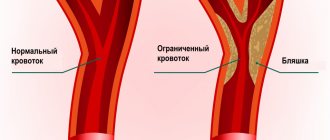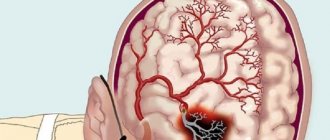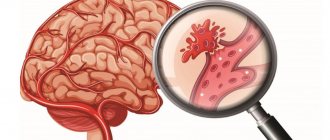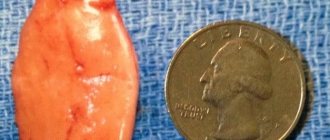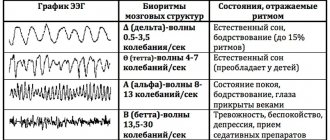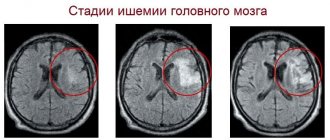Thoracic and abdominal aorta
Circulation circles.
CIRCLES OF BLOOD CIRCULATION. THORACIC AND ABDOMINAL AORTA. ARTERIES OF THE THORACIC AND PELVIC LIMB.
Lecture 11
Aorta. Brachiocephalic trunk.
The aorta emerges as an unpaired trunk at the base of the heart, gives off the brachiocephalic trunk and, in the form of an aortic arch, reaches the sixth thoracic segment.
The brachiocephalic trunk is expressed in horses and cattle. Its branches supply blood to the head, neck, chest wall and thoracic limbs.
Questions for self-control
1) Name the structure of the aorta.
2) Name the structure of the heart.
BIBLIOGRAPHY
Main
1. Klimov, A.F. Anatomy of domestic animals / A.F. Klimov , A.I. Akaevsky. – St. Petersburg: Publishing House “Lan”, 2011. – p.1039
Additional
1. Anatomy of domestic animals / I.V. Khrustaleva, [etc.]. – M.: “Kolos”, 2004. – p. 703.
2. Khrustaleva, I. V. Anatomy of domestic animals. / I.V. Khrustaleva, A.I. Akaevsky, Yu.F. Yudichev. – M.: “Kolos”, 2002. – p.543.
3. Morphology of agricultural animals / V.F. Vrakin, [etc.]. – M., Agropromizdat, 1991. – p. 527.
There are major, minor, coronary, embryonic and hepatic circulation circles.
Thoracic aorta - aorta thoracica passes on the left along the ventral surface of the thoracic vertebral bodies between the layers of the mediastinum, to the right of it are the thoracic lymphatic duct and the right azygos vein. Metamerically paired intercostal arteries - aa - depart from the dorsal wall of the thoracic aorta. intercostales dorsales. Each of them follows ventrally along the caudal edge of the rib in its vascular groove, together with the vein and nerve of the same name. From each intercostal artery depart dorsally: spinal branches - m. spinales, which enter the spinal canal through the vertebral foramen and supply blood to the spinal cord and its membranes; dorsal branches - gg. dorsales supply blood to the extensors of the back and the skin of this area.
In the region of the last thoracic vertebrae, the thoracic aorta passes through the aortic opening of the diaphragm (between its legs in horses and pigs) or in the left leg (in ruminants and carnivores) into the abdominal cavity, where it becomes the abdominal aorta.
The abdominal aorta - aorta abdoniinalis lies ventral to the vertebral column to the left of the caudal vena cava. On its way to the entrance to the pelvic cavity, it gives off parietal branches in the cavity of the spinal column, the walls of the abdominal cavity and visceral branches to the internal organs of the abdominal cavity. The parietal branches include: paired caudal phrenic, abdominal lumbar and circumferential deep iliac arteries. The visceral branches of the abdominal aorta are three unpaired vessels: the celiac, cranial and caudal mesenteric arteries, which supply blood to the digestive organs, and paired ones - the renal, adrenal, renal (in males) or ovarian (in females) arteries.
Caudal phrenic artery - a. phrenica caudalis is steamy, branches off from the abdominal aorta in the area of the aortic opening of the diaphragm and follows into its legs. This artery also gives off branches to the adrenal glands (in cattle and pigs they often arise from the celiac artery; in horses they are absent).
Paired cranial abdominal artery - a. abdoniinalis cranial is found only in pigs and carnivores, arises at the level of or behind the cranial mesenteric artery, and supplies the muscles of the lower back and abdomen.
Paired lumbar arteries - aa. lumbales in the amount of 5-6 pairs emerge from the dorsal wall of the aorta, with the last pair extending behind the branch of the external iliac arteries.
The celiac artery, the very first one directly behind the diaphragm, departs from the abdominal aorta - a. celiaca The vessel has a short trunk and is immediately divided into three branches: a) splenic - the largest; b) left gastric - the thinnest; c) hepatic, occupying a middle position in size.
a) Splenic artery - a. lienalis follows to the spleen and passes into the left gastroepiploic artery - a. gastro epiploica (diverticuli) sinistra, which in the area of the greater curvature of the stomach anastomoses with the right artery of the same name. The splenic artery also gives off branches to the stomach, pancreas; in pigs, the left gastric artery departs from it - a. gastrica sinistra.
b) Left gastric artery - a. gastrica sinistra follows the lesser curvature of the single-chamber stomach and gives off branches to the pancreas. c) Hepatic artery - a. hepatica enters the gate of the liver along with the portal vein. Before entering the liver, it gives off branches to the duodenum, pancreas and stomach. It sends the right gastric artery to the lesser curvature of the stomach - a. gastrica dextra and gastroduodenal artery - a. gastroduodenalis. From the latter, the right gastroepiploic artery departs to the greater curvature of the stomach - a. gastroepiploica dextra and pancreatic duodenal artery -a. pancreaticoduodenalis.
The celiac artery in adult cattle reaches a length of 8.5 cm and has a diameter of 9.8 mm. Having given off the hepatic artery, it divides into the common trunk of the splenic and right cicatricial arteries - truncus communis lienoruminalis dextra, the left cicatricial and left common gastric arteries.
Splenic artery - a. lienalis emerges from the common trunk of the splenic and right cicatricial arteries and, before entering the hilum of the spleen, is divided into several branches.
Right cicatricial artery - a. ruminalis dextra is located in the right longitudinal and caudal grooves of the scar. It is a continuation of the common trunk. On the right surface of the scar, the right ventral and dorsal coronary arteries depart from it. Upon exiting the left surface of the scar, the right scar artery is dichotomously divided into the left ventral and dorsal coronary arteries.
Left cicatricial artery - a. ruminalis sinistra passes in the cranial and left longitudinal grooves of the scar. The reticular cicatricial artery departs from it - a. ruminoreticularis.
Left common gastric artery - a. gastrica sinistra communis, before reaching the book, is dichotomously divided into the left gastric artery - a. gastrica sinistra, located in the area of the greater curvature of the book and the lesser curvature of the abomasum, and the left gastroepiploic artery - a. gastroepiploica sinistra, extending onto the greater curvature of the abomasum.
Hepatic artery - a. hepatica gives off the right gastric - a. gastrica dextra and gastroduodenal artery - a. gastroduodenalis. The latter, without a visible border, passes into the right gastroepiploic artery - a. gastroepiploica dextra. The cranial pancreatic-duodenal artery departs from it - a. pancreaticoduodenalis cranialis.
Behind the celiac artery, the unpaired cranial mesenteric artery departs from the abdominal aorta - a. mesentrica cranialis, which supplies blood to the small and large intestines. It sends a large number of jejunal arteries to the small intestine - aa. jeju-nales, which pass in the mesentery and near the intestinal wall and anastomose with the branches of the pancreatic-duodenal and caudal mesenteric arteries. For the colon, the cranial mesenteric artery gives off the ileo-menopausal artery - a. ileocolica, which is divided into the colon branch - M. colicus for the beginning of the colon, the artery of the cecum - M. cecalis and the right colic arteries - aa. colicae dextrae for the right knee of the colon (in horses).
Behind the renal arteries there are paired arteries for the gonads, in males this is the testicular artery (internal spermatic) - a. testicularis, and in females - ovarian - a. ovarica. The testicular artery passes through the inguinal canal as part of the spermatic cord and branches into the testis, epididymis and vas deferens. The ovarian artery sends branches to the oviducts and to the uterine horn (in the horse).
Caudal mesenteric artery - a. mesenlerialis caudalis departs from the abdominal aorta in the region of the last lumbar vertebrae, it divides into the left colic artery - a. colica sinistra, which branches in the descending part of the colon (in horses also in the small colon) and into the cranial artery of the rectum - a. rectalis cranialis, which anastomoses with the caudal artery of the rectum.
Thoracic aorta
The descending aorta is the longest part of the aorta. It begins in the area of the fourth thoracic vertebra, and is located in the posterior mediastinum, where it is attached to the spinal column and is divided into two parts - the thoracic aorta and the abdominal aorta. The upper zone of the thoracic aorta is located somewhat anterior and to the left of the esophagus. Then, approximately in the area of the thoracic vertebrae numbered eight and nine, the aorta goes around the esophagus on the left, and then extends to its posterior surface. On the right side of the thoracic zone of the aorta there is a vein that does not have a pair, and the left side is decorated with the parietal pleura.
The thoracic aorta, which is located in the chest cavity, has parietal branches; posterior intercostal arteries; visceral branches leading to the posterior mediastinum, or rather to the organs located there. The thoracic aorta can be divided into two groups of branches. Thus, we get branches that are inside the walls and branches that go next to the walls. The internal branches contain bronchial and esophageal, also mediastinal, that is, mediastinal, and pericardial branches.
The bronchial branches related to the vessel - the thoracic aorta, have branches that, when working together with the bronchi, saturate the lung tissue with the necessary blood, and their extreme branches reach the lymph nodes related to the bronchi, and also go to the esophagus and pleura, and to the bursa, located next to the heart. They are present in the amount of two, in some cases there are more. There are 3-6 esophageal branches, they pass to the wall of the esophagus, then split into two branches. One connects to the ventricular artery located on the left. The other does the same, but only with the inferior thyroid artery. The mediastinal branches themselves look like small vessels that feed the tissue at the junction, lymph nodes and the mediastinum. The pericardial branches allow the posterior part of the pericardial sac to live.
By parietal branches we mean the phrenic and intercostal arteries. The first allow you to enjoy the blood of the diaphragm. But the second ones, or rather 9 out of 10 of which extend to the intercostal spaces, and the lower ones are located under the 12 ribs. They are called in medicine the subcostal arteries. In the area of the head of the ribs, all arteries are divided into the frontal branch, which supplies blood to the muscles of the intercostal space, some abdominal muscles, as well as the mammary gland and skin of the chest.
